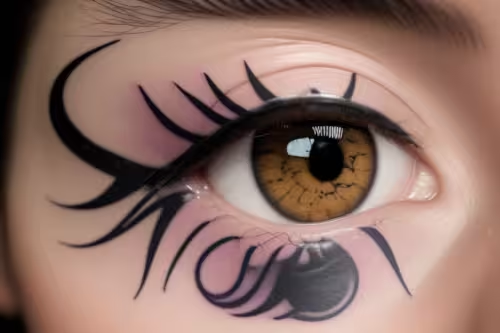Tattoo in the Eye: Exploring the Trend, Risks, and What You Need to Know

Tattoo in the Eye: Exploring the Trend, Risks, and What You Need to Know
The world of body modification has seen some truly fascinating trends over the years, but one of the most extreme and controversial is the “tattoo in the eye,” also known as scleral tattooing. This procedure involves injecting ink into the sclera—the white part of the eye—to change its color permanently. While the idea of permanently altering the appearance of your eyes might sound intriguing to some, it’s essential to understand the risks and implications involved.

Scleral tattoos have garnered attention for their striking and otherworldly appearance, but they also come with significant health risks. This article will delve into the growing trend of eye tattoos, the procedure itself, the associated risks, and what you should consider before deciding to undergo such a modification. Whether you’re considering this procedure yourself or are simply curious about it, this comprehensive guide will provide the information you need to make an informed decision.
What is Scleral Tattooing?
Scleral tattooing is a type of body modification where ink is injected into the sclera—the white part of the eye—using a needle. Unlike traditional tattoos that are applied to the skin, scleral tattoos change the color of the eye itself, creating a dramatic and often startling effect.
Key Aspects of Scleral Tattooing:
- Procedure: Involves injecting ink directly into the sclera.
- Purpose: Primarily for cosmetic or aesthetic reasons, though it may also be done as a form of artistic expression.
- Permanence: The change is typically permanent, with the ink spreading across the sclera over time.
- Popularity: While still a niche trend, scleral tattooing has gained attention within the body modification community.
The procedure is highly controversial and is generally not recommended by medical professionals due to the high risk of complications.

How is the Procedure Done?
Scleral tattooing is an invasive procedure that requires a steady hand and a deep understanding of eye anatomy. It’s not a procedure performed by traditional tattoo artists but rather by individuals with specialized training in body modification.
Step-by-Step Overview of Scleral Tattooing:
- Consultation: Before the procedure, a consultation is typically held to discuss the desired outcome and the risks involved.
- Anesthesia: Local anesthesia is applied to numb the eye and reduce discomfort during the procedure.
- Ink Injection: Using a fine needle, the practitioner injects ink into the sclera. The ink spreads between the layers of the sclera, coloring the white part of the eye.
- Aftercare: After the procedure, specific aftercare instructions are provided to help reduce the risk of infection and promote healing.
Important Note: This procedure is irreversible, and the ink can spread unpredictably, leading to uneven coloring or other unwanted effects.
Why Do People Get Eye Tattoos?
The motivations behind getting an eye tattoo can vary widely. For some, it’s a way to stand out or make a bold statement. Others may see it as an ultimate form of self-expression or body modification.
Common Reasons for Getting a Scleral Tattoo:
- Aesthetic Appeal: The striking appearance of colored sclera can be visually captivating.
- Artistic Expression: Some individuals view body modification, including scleral tattoos, as a form of art.
- Unique Identity: Eye tattoos can help individuals feel unique and different from the norm.
- Rebellion or Subculture Identification: For some, scleral tattooing is a way to identify with certain subcultures or to rebel against societal norms.
While these reasons might seem compelling, it’s crucial to weigh them against the potential risks, which can be severe.
The Risks and Dangers of Scleral Tattooing
Scleral tattooing is not without significant risks. Unlike traditional tattoos, which are applied to the skin, scleral tattoos involve injecting ink into one of the most delicate and sensitive parts of the body. The potential complications are numerous and can be life-altering.
Major Risks Associated with Scleral Tattooing:
- Infection:
- The eye is a highly sensitive organ, and introducing foreign substances like tattoo ink can lead to serious infections. Eye infections can cause pain, swelling, and in severe cases, blindness.
- Vision Loss:
- The most severe risk associated with scleral tattooing is the potential for partial or complete vision loss. If the ink penetrates too deeply or spreads unpredictably, it can damage the retina or other critical structures within the eye.
- Pain and Discomfort:
- Even with anesthesia, the procedure can be painful, and discomfort may persist for days or weeks afterward. Some people experience chronic pain or irritation following the procedure.
- Permanent Damage:
- Once ink is injected into the sclera, it’s there for good. If something goes wrong during the procedure, there is no way to remove the ink without causing further damage. This can lead to permanent scarring or disfigurement of the eye.
- Allergic Reactions:
- Although rare, some individuals may have an allergic reaction to the ink used in scleral tattoos. This can cause inflammation, redness, and other complications.
- Unpredictable Results:
- The ink can spread unevenly, leading to an appearance that may not match the individual’s expectations. Over time, the ink can also migrate, causing further changes to the appearance of the eye.
Case Studies and Examples: There have been numerous reports of complications arising from scleral tattoos. In some cases, individuals have lost their sight, required surgery, or experienced chronic pain. These stories highlight the serious nature of the risks involved.
Legal and Ethical Considerations
In many countries, scleral tattooing is not regulated, meaning anyone with the necessary tools can perform the procedure, regardless of their qualifications. This lack of regulation poses significant ethical concerns, as individuals seeking this procedure may not fully understand the risks or may be misled by practitioners without adequate training.
Legal Status:
- Varies by Region: In some areas, scleral tattooing is illegal, while in others, it is unregulated.
- Lack of Professional Oversight: Without proper oversight, the risks of unqualified individuals performing the procedure increase.
Ethical Concerns:
- Informed Consent: Given the serious risks, there is a concern about whether individuals are truly informed about the potential consequences of scleral tattooing.
- Practitioner Qualifications: Many practitioners lack formal medical training, raising concerns about their ability to perform the procedure safely.
What You Should Consider Before Getting a Scleral Tattoo
If you’re considering getting a scleral tattoo, it’s vital to take the time to thoroughly research and reflect on your decision. Given the high risks, this is not a procedure to take lightly.
Questions to Ask Yourself:
- Am I fully aware of the risks involved, including the possibility of vision loss?
- Have I consulted with a medical professional to understand the potential long-term consequences?
- Why do I want this tattoo, and is it worth the potential dangers?
- Am I prepared for the permanent nature of this modification, including any unexpected outcomes?
- Have I researched the qualifications of the practitioner thoroughly?
Steps to Take:
- Consult a Medical Professional: Before undergoing the procedure, speak with an eye specialist to understand the risks.
- Research Practitioners: If you decide to proceed, choose a practitioner with extensive experience and positive reviews. Ensure they use sterile equipment and high-quality ink.
- Consider Alternatives: If you’re drawn to the idea of altering your eye color, consider less invasive alternatives, such as colored contact lenses.
Tattooing the eye, or scleral tattooing, is a bold and extreme form of body modification that has garnered attention for its striking appearance. However, it’s also fraught with significant risks, including infection, permanent vision loss, and unpredictable results. While the aesthetic appeal might be compelling for some, the potential dangers far outweigh the benefits for many.
If you’re considering this procedure, it’s crucial to thoroughly research the risks, consult with medical professionals, and carefully weigh the pros and cons. Remember, once the ink is in your eye, it’s there for life, and the consequences of a poor decision could be devastating.
Before making any decisions, consider whether there are safer alternatives that might satisfy your desire for self-expression without putting your health and vision at risk. Ultimately, the choice is yours, but it’s essential to approach it with caution and informed judgment.



